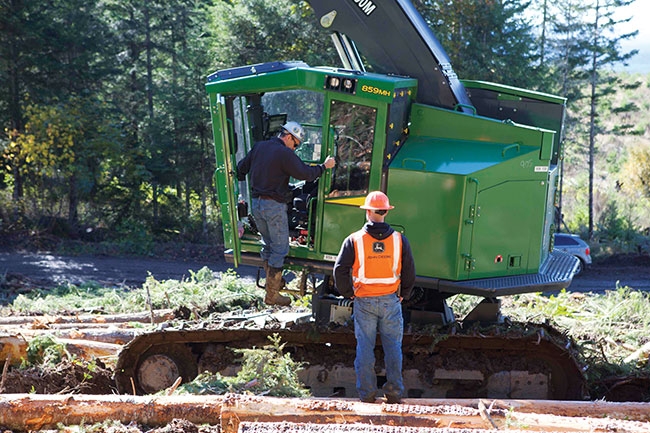
New Gear
Harvesting
New Gear
Equipment refresh: Forestry machine maintenance 101
Sept. 27, 2018 - While preventative maintenance may seem elementary, it is an important part of ensuring the health of machines. To retain performance and help machines power through stubborn conditions, loggers are encouraged to work closely with their dealers, implement internal processes to streamline machine maintenance and utilize available technology solutions to maximize machine productivity.
September 27, 2018 By Kevin Drake
 Performing preventative maintenance
Performing preventative maintenance To help refresh crews, below are five best practices for keeping machines up and running.
Daily walk arounds
Operators should begin each day with a machine walk around. Machine walk arounds ensure everything is in order before beginning each workday. Operators should review pins and bushings, hoses and fittings, and identify leaks. Hydraulic hoses and belts should also be checked for wear and tear and be replaced if damaged. Examining electrical components and electrical connectors and wiring is also important, as damage to these parts can be costly. Monitoring for any cuts or scars, as well as signs of water damage on connectors is recommended.
Tires should also be carefully checked, ensuring they are properly inflated and ready for the unpredictable terrain ahead. Tire tread is also important to monitor. Keep an eye out for depleted areas and replace tires as necessary to get ahead of any surprise maintenance issues. Take the time to review chains and tracks while changing any damaged or loose areas along the way. Windshields as well as wipers must be in optimal shape for visibility purposes before starting the day. Battery fluid levels should be regularly checked to ensure the charge holding capacity is still up to par.
Once the walk around is finished, the operator should then assume their position in the machine and double-check secondary exits to make sure they are well lubricated and tightly sealed. Testing both the parking and work brakes is also important, confirming that they are holding properly.
To avoid downtime, loggers should inspect machines daily to catch small problems before they become significant issues.
Focus on fuel
The quality and cleanliness of fuel is imperative for machines to run at peak productivity. Operators should carefully examine how fuel is being delivered and take samples upon arrival in a clean, white or clear container. Make sure the fuel tanks in the machine are debris-free and the fuel itself is bright and clear, as rubble in a machine can cause costly mechanical issues. Also, consider where the fuel holding tank is located. It is good practice to keep the fuel holding tank in an area of consistent temperature, as notable temperature changes create condensation and increase the potential of water inside tanks.
From a machine perspective, it is important to follow a strict maintenance schedule, including the replacement of fuel filters at proper intervals, per the manufacturer’s stipulations. Draining the primary filters, which are used to separate free water from the fuel and following the manufacturer guidelines is also very important to avoid downtime. Ensure the proper grade of fuel is being used to for the ambient temperature.
Refresh crews
Find opportunities to refresh the crew’s knowledge at the beginning of each season. Empowering the crew to learn new maintenance tips as well as the basic inner workings of the machines gives them ownership and ensures that machines are properly maintained.
First and foremost, focus on safety. Use this time to listen to the crew and ensure they have all the necessary gear to keep them safe. Consider implementing a refresher course for employees. A few topics to discuss include checklists for proper daily and weekly inspections, maintenance activities and operating tips.
Utilize a dealer
While maintenance plans and team refreshers are important tools, loggers need to consider their most important resource: their dealer. Understanding the complexity and challenges of the logging industry, dealers are a loggers’ No. 1 ally, helping them to plan appropriately for optimal machine uptime and profitability.
Loggers should work with their dealer to create a regimented maintenance plan that works for them. A dealer can be the most valuable resource to help educate about machine maintenance for a profitable business.
For complex jobs, the dealer has the training to get the job done in a quicker timeframe. Additionally, dealers have the resources needed to complete major repairs, while also doing an inspection. Many owners do not realize that maintenance and parts can often be combined with their financing package when purchasing a new machine. The dealer will be able to walk through all of the options, helping the logger identify the best package for their unique business.
Technology
It is more important than ever for today’s loggers to take advantage of technology to maximize machine productivity. Telematics has come a long way in the past decade, and more owners and operators are taking advantage of these solutions to increase profitability. Customers are relying on platforms such as the John Deere JDLink telematics solutions to provide an inside look at machines and anticipate potential downtime.
Through technology, customers are able to analyze machine performance and better understand their productivity. From operator effectiveness to fuel usage, telematics offers loggers a tool to measure productivity, creating benchmarks that can be used for future improvement and ultimately cut operating costs.
Telematics also provide insight to machine health, allowing owners to identify maintenance problems as early as possible. With access to machine health notifications, owners and dealers are alerted as soon as a problem arises, allowing them to get ahead of it and minimize downtime.
In this ever-changing industry, it is imperative for loggers to explore new tools that can help them further optimize their machines and ultimately contribute a healthy bottom line to keep them in business for years to come.
Kevin Drake is a manager of customer product support for John Deere Forestry.
Print this page